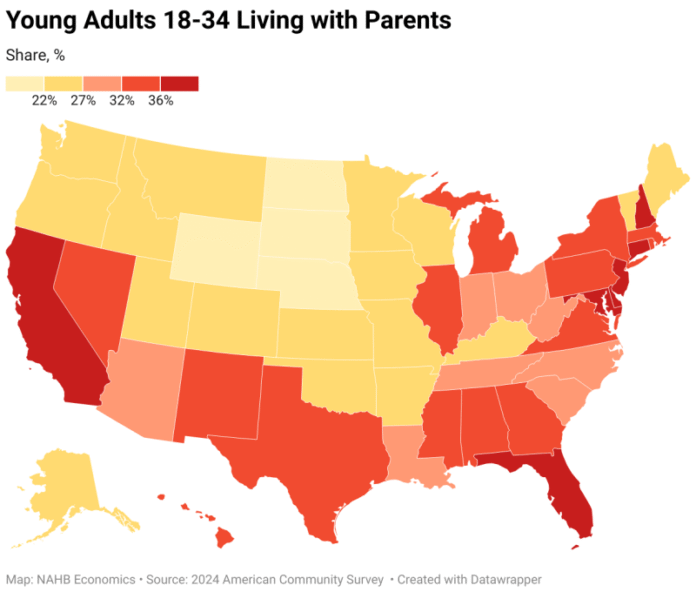The share of young adults living with parents increased in 2024, interrupting the post-pandemic trend of moving out of parental homes. Nearly a third (32.5%) of adults ages 18-34 lived with their parents according to the latest 2024 American Community Survey (ACS). This is up from 31.8% in 2023, although it remains below the pre-pandemic peak of 34.5% in 2017. Geospatial analysis of the 2024 ACS data shows significant differences across states, with the Southern and Northeastern states having some of the highest shares of young adults living in parental homes.
While the national average share increased to 31.8%, over 40% of young adults ages 18-34 lived in parental homes in New Jersey (44%) and Connecticut (41%). California and Maryland register the nation’s third and fourth-highest shares of 39% and 38%, respectively. At the opposite end of the spectrum are states with less than a fifth of young adults living with parents. The fast-growing North Dakota records the nation’s lowest share of 12%, while the neighboring South Dakota registers 18%. In the District of Columbia, where the job market was relatively stable in 2024, less than 13% of young adults lived with their parents. The cluster of north-central U.S. states completes the nation’s list with the lowest percentages of young adults remaining in parental homes.

The elevated shares of young adults living with parents in high-cost coastal areas underscore the role of housing affordability in driving this trend. Statistical analysis confirms a clear link between prohibitively expensive housing, especially rentals, and the high prevalence of young adults residing with their parents. The states with higher shares of renters paying 30 percent or more of their income on housing, and therefore considered cost-burdened, tend to register higher shares of young adults living with parents.
The reported shares come from the ACS Summary files that do not separate college-age adults (ages 18-24) from the older subset (ages 25-34). Once the ACS public microdata becomes available, it will be worth understanding whether the younger and older subgroups experienced divergent trends over the last year.






